1990 VOLKSWAGEN TRANSPORTER recommended oil
[x] Cancel search: recommended oilPage 99 of 165
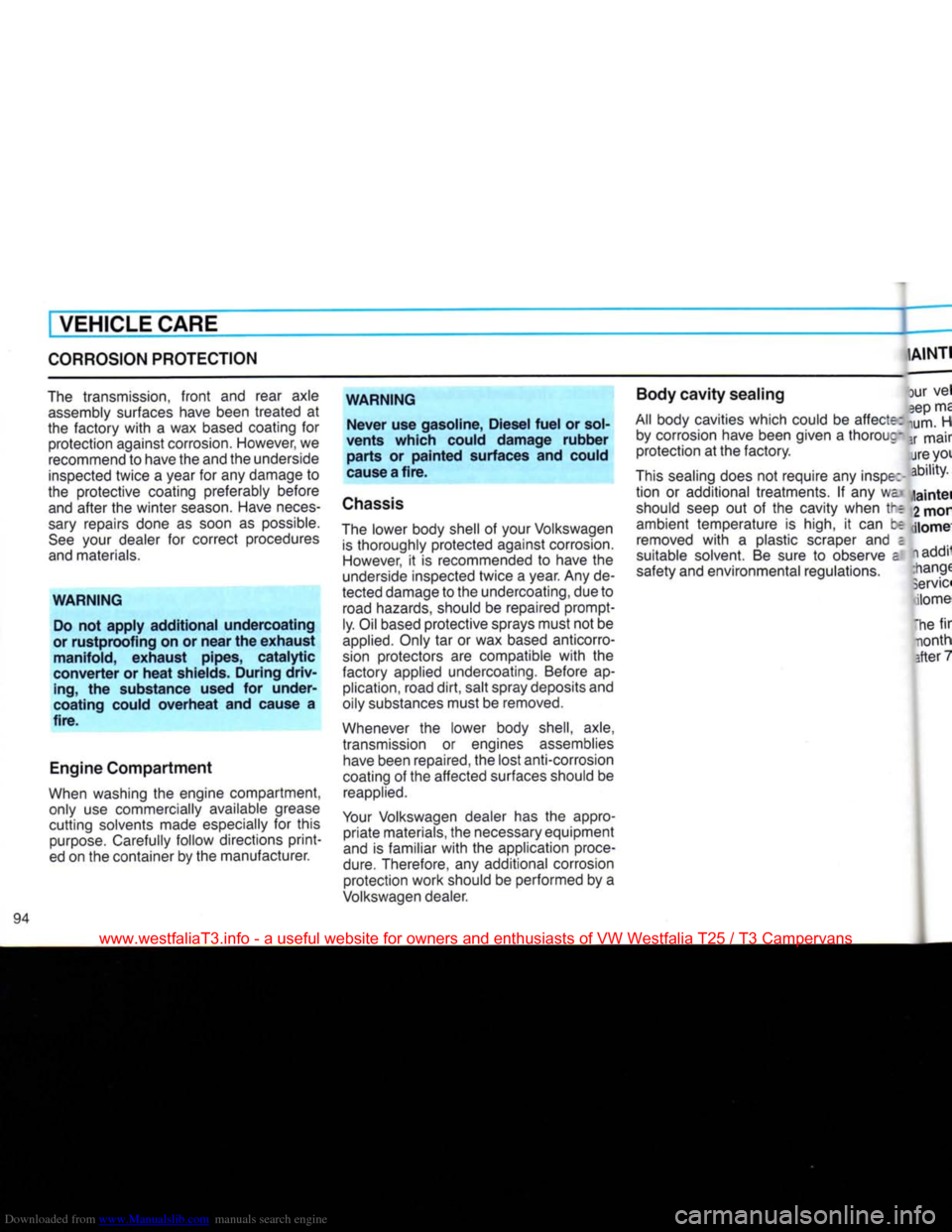
Downloaded from www.Manualslib.com manuals search engine
VEHICLE CARE
CORROSION
PROTECTION
The transmission,
front
and rear axle
assembly
surfaces have been treated at
the factory
with
a wax based coating for protection against corrosion. However, we
recommend to have the and the underside
inspected twice a year for any damage to
the protective coating preferably before and after the winter
season.
Have
neces
sary
repairs done as soon as possible.
See
your dealer for correct procedures
and materials.
WARNING
Do not
apply
additional
undercoating
or
rustproofing
on or
near
the
exhaust
manifold,
exhaust
pipes,
catalytic
converter
or
heat
shields.
During
driv
ing, the substance used for
under-
coating
could
overheat
and cause a
fire.
Engine
Compartment
When washing the engine compartment, only use commercially available grease
cutting solvents made especially for this
purpose.
Carefully follow directions
print
ed
on the container by the manufacturer.
WARNING
Never
use gasoline,
Diesel
fuel
or sol
vents
which
could
damage
rubber
parts
or
painted
surfaces and could
cause a
fire.
Chassis
The lower body shell of your Volkswagen
is
thoroughly protected against corrosion. However, it is recommended to have the
underside inspected twice a year. Any de
tected damage to the undercoating, due to road hazards, should be repaired prompt
ly. Oil based protective sprays must not be
applied.
Only tar or wax based anticorro-
sion
protectors are compatible
with
the
factory applied undercoating. Before ap plication, road
dirt,
salt spray deposits and
oily substances must be removed.
Whenever
the lower body
shell,
axle, transmission or engines assemblies have been repaired, the lost anti-corrosion
coating of the affected surfaces should be
reapplied.
Your
Volkswagen dealer has the appro priate materials, the necessary equipment
and is familiar
with
the application proce
dure. Therefore, any additional corrosion protection work should be performed by a
Volkswagen
dealer.
Body
cavity sealing
All
body cavities which could be affecte: by corrosion have been given a thorouc"
protection at the factory.
This
sealing does not require any inspe:
tion
or additional treatments. If any wa should seep out of the cavity when tN
ambient temperature is high, it can M removed
with
a plastic scraper and -.
suitable solvent. Be sure to observe a
safety and environmental regulations.
94
www.westfaliaT3.info - a useful website for owners and enthusiasts of VW Westfalia T25 / T3 Campervans
Page 105 of 165
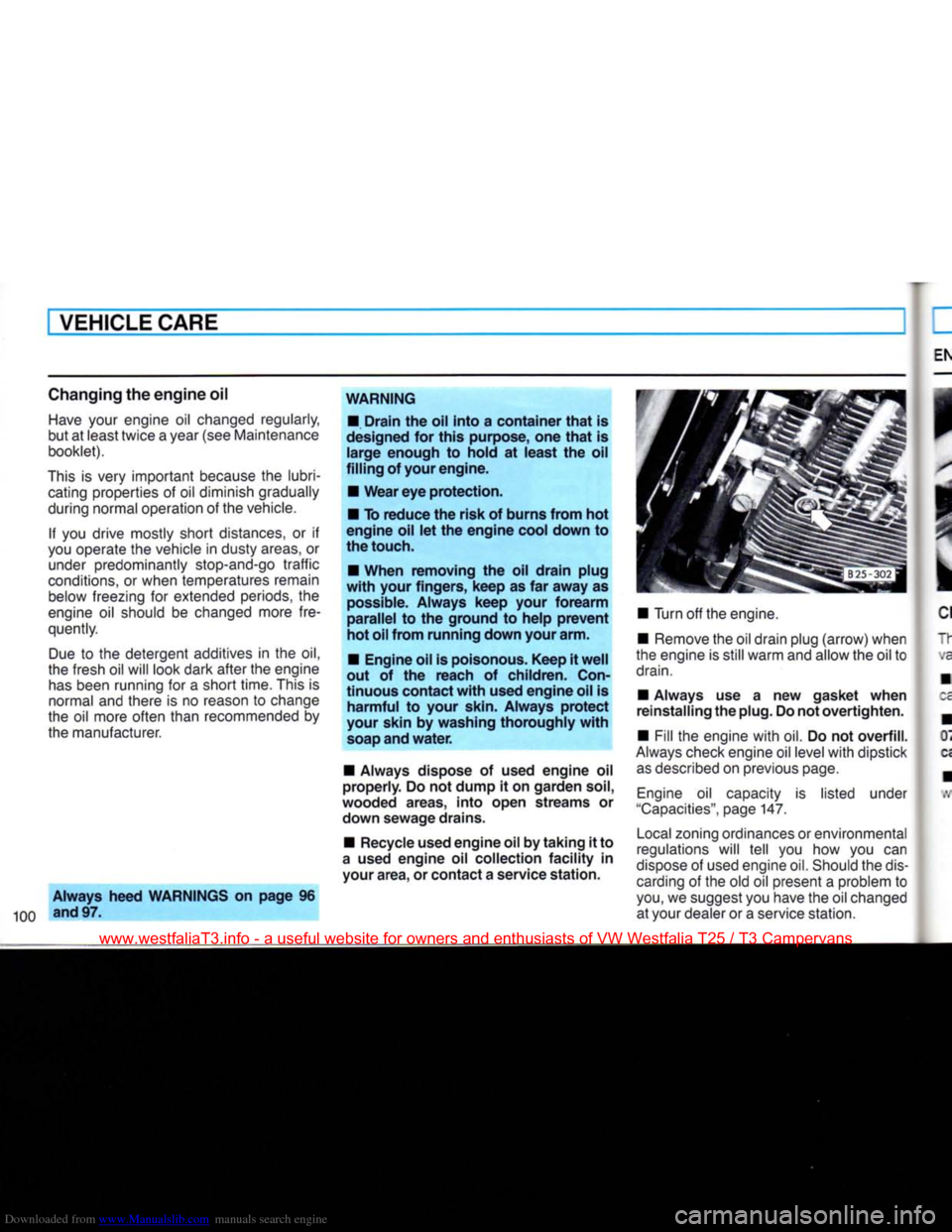
Downloaded from www.Manualslib.com manuals search engine
VEHICLE CARE
Changing the
engine
oil
Have
your engine oil changed regularly,
but at least twice a year (see Maintenance
booklet).
This
is very important because the lubri cating properties of oil diminish gradually
during normal operation of the vehicle.
If you drive mostly short distances, or if
you operate the vehicle in dusty
areas,
or under predominantly stop-and-go traffic
conditions, or when temperatures remain below freezing for extended periods, the
engine oil should be changed more fre
quently.
Due
to the detergent additives in the oil,
the fresh oil will look dark after the engine
has
been running for a short time. This is
normal and there is no reason to change
the oil more often than recommended by
the manufacturer.
Always
heed
WARNINGS
on
page
96
100 and97-
WARNING
•
Drain
the oil
into
a
container
that
is
designed for
this
purpose, one
that
is
large
enough to hold at
least
the oil
filling
of your
engine.
•
Wear
eye
protection.
• To
reduce
the
risk
of burns
from
hot
engine
oil let the
engine
cool
down
to
the touch.
•
When
removing
the oil
drain
plug
with
your fingers,
keep
as far
away
as possible.
Always
keep
your
forearm
parallel
to the ground to
help
prevent
hot oil
from
running
down
your arm.
• Engine oil is poisonous. Keep it
well
out of the
reach
of children. Con
tinuous
contact
with
used
engine
oil is
harmful
to your skin.
Always
protect
your skin by
washing
thoroughly
with
soap and
water.
•
Always
dispose of used
engine
oil
properly.
Do not
dump
it on
garden
soil,
wooded
areas,
into
open
streams
or
down
sewage
drains.
• Recycle used
engine
oil by
taking
it to
a used
engine
oil collection
facility
in
your
area,
or
contact
a service
station.
• Turn off the engine.
• Remove the oil drain plug (arrow) when
the engine is still warm and allow the oil to
drain.
•
Always
use a new
gasket
when
reinstalling
the plug. Do not
overtighten.
•
Fill
the engine
with
oil. Do not
overfill.
Always
check engine oil level
with
dipstick
as
described on previous page.
Engine
oil capacity is listed under
"Capacities",
page 147.
Local
zoning ordinances or environmental
regulations will tell you how you can
dispose
of used engine oil. Should the dis carding of the old oil present a problem to
you,
we suggest you have the oil changed
at your dealer or a service station.
www.westfaliaT3.info - a useful website for owners and enthusiasts of VW Westfalia T25 / T3 Campervans
Page 108 of 165
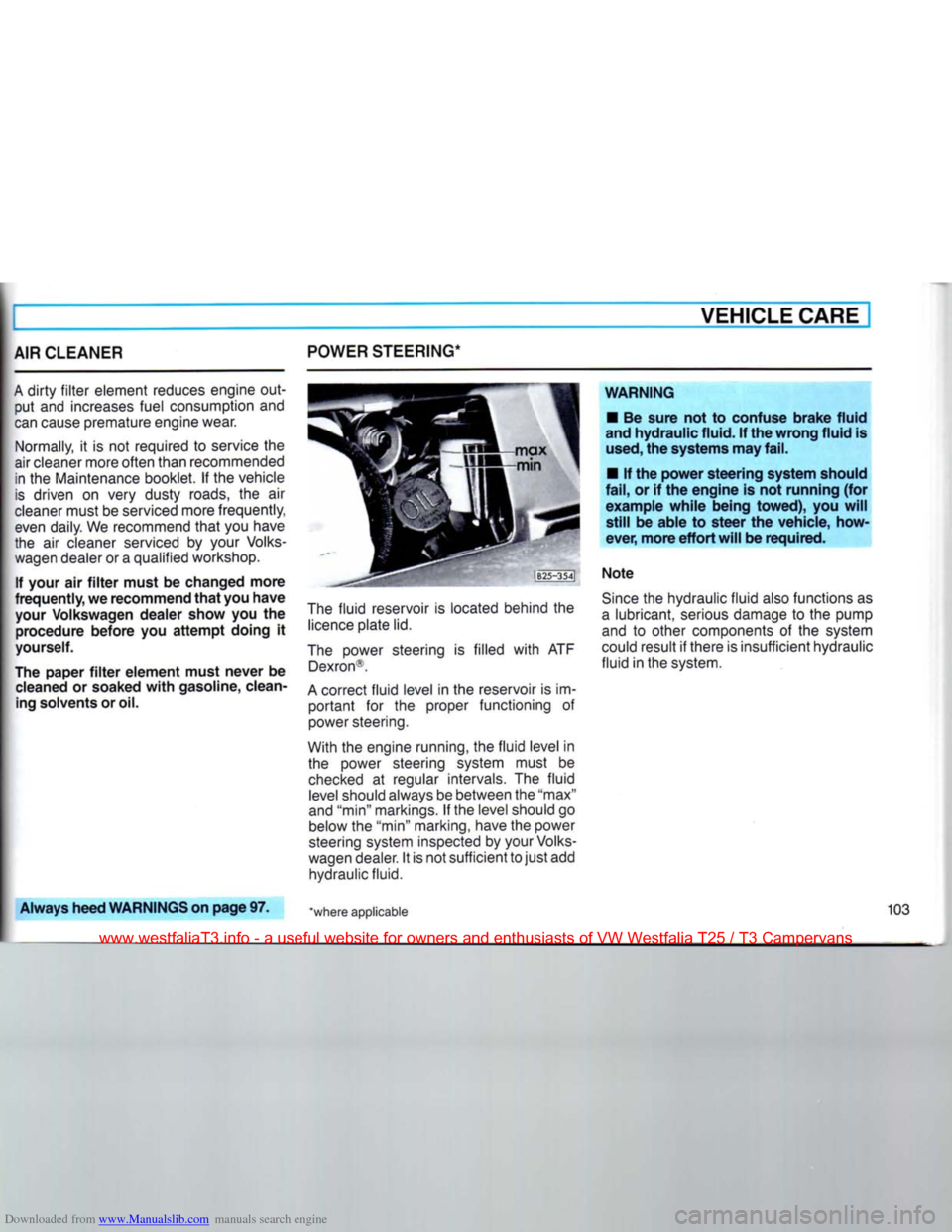
Downloaded from www.Manualslib.com manuals search engine
VEHICLE
CARE
I
AIR CLEANER
A
dirty
filter
element reduces engine
out
put and increases fuel consumption and
can
cause premature engine wear.
Normally, it is not required to service the
air cleaner more often than recommended in the Maintenance booklet. If the vehicle
is
driven on very dusty roads, the air
cleaner
must be serviced more frequently,
even
daily. We recommend
that
you have
the air cleaner serviced by your
Volks
wagen dealer or a qualified workshop.
If
your
air
filter
must
be
changed more
frequently,
we
recommend
that
you have
your
Volkswagen dealer show
you the
procedure
before
you
attempt
doing
it
yourself.
The
paper
filter
element must never
be
cleaned
or
soaked
with
gasoline, clean
ing
solvents or oil. POWER STEERING*
The
fluid
reservoir is located behind the
licence
plate lid.
The
power steering is filled
with
ATF Dexron®.
A
correct
fluid
level in the reservoir is im
portant
for the proper functioning of
power steering.
With the engine running, the
fluid
level in the power steering system must be
checked
at regular intervals. The
fluid
level
should always be between the "max"
and "min" markings. If the level should go below the "min" marking, have the power
steering system inspected by your
Volks
wagen dealer. It is not sufficient to
just
add hydraulic fluid.
WARNING
•
Be
sure
not to
confuse brake fluid
and
hydraulic fluid.
If
the wrong fluid
is
used,
the systems may fail.
•
If the
power steering system should
fail,
or if the
engine
is not
running
(for
example
while
being
towed),
you
will
still
be
able
to
steer
the
vehicle, how
ever, more
effort
will
be required.
Note
Since
the hydraulic
fluid
also functions as
a
lubricant, serious damage to the pump
and to other components of the system
could result if there is insufficient hydraulic
fluid
in the system.
Always
heed WARNINGS on page
97. "where applicable
www.westfaliaT3.info - a useful website for owners and enthusiasts of VW Westfalia T25 / T3 Campervans
Page 121 of 165
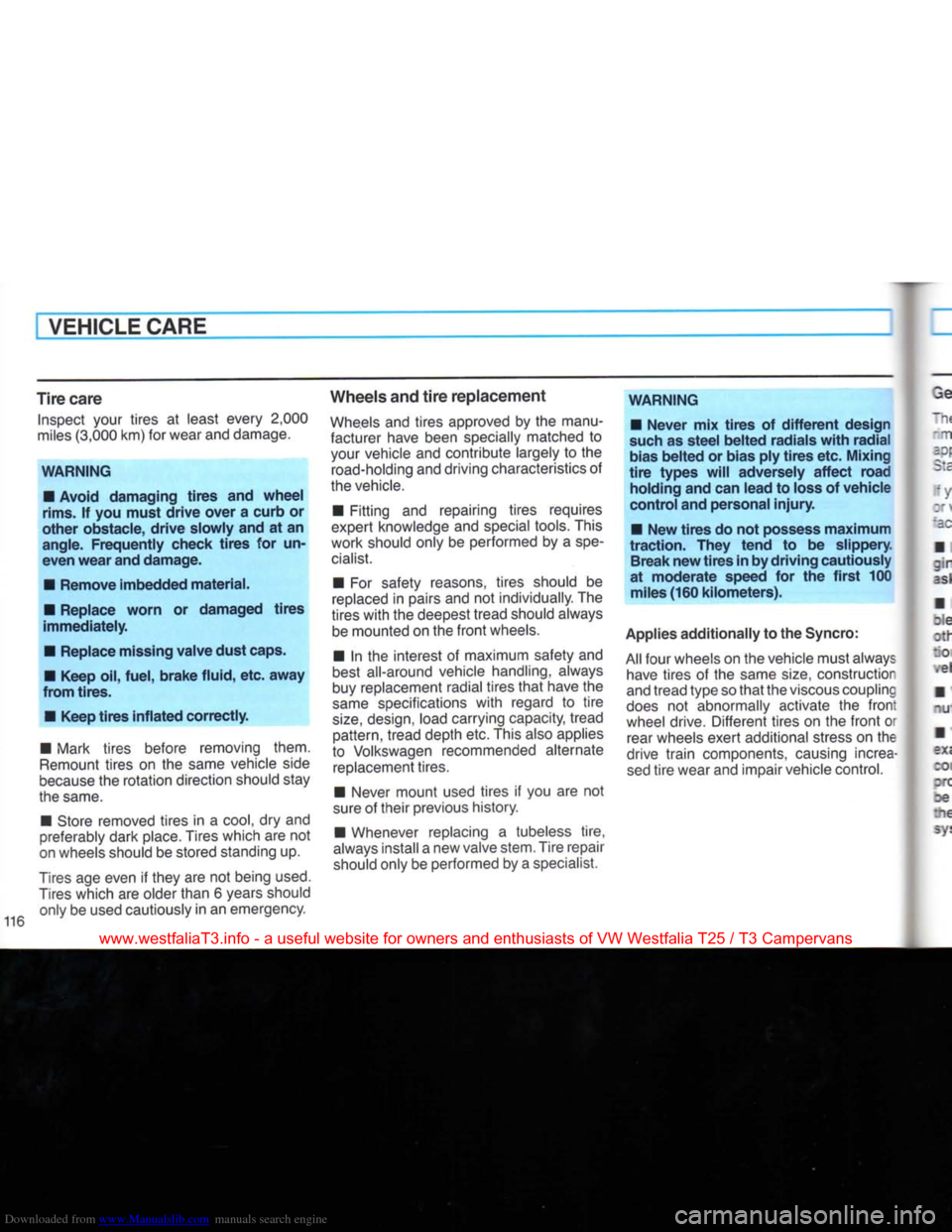
Downloaded from www.Manualslib.com manuals search engine
VEHICLE CARE
Tire
care
Inspect your tires at least every 2,000
miles (3,000 km) for wear and damage.
WARNING
• Avoid
damaging
tires
and
wheel
rims.
If you
must
drive
over
a
curb
or
other
obstacle,
drive
slowly
and at an
angle.
Frequently
check
tires
for un
even
wear
and
damage.
•
Remove
imbedded
material.
•
Replace
worn
or
damaged
tires
immediately.
•
Replace
missing
valve
dust
caps.
• Keep oil,
fuel,
brake
fluid,
etc.
away
from
tires.
• Keep
tires
inflated
correctly.
• Mark tires before removing them.
Remount tires on the same vehicle side
because
the rotation direction should stay
the same.
• Store removed tires in a
cool,
dry and
preferably dark place. Tires which are not
on wheels should be stored standing up.
Tires
age even if they are not being
used.
Tires
which are older than 6 years should only be used cautiously in an emergency.
Wheels
and
tire
replacement
Wheels
and tires approved by the manu
facturer have been specially matched to
your vehicle and contribute largely to the road-holding and driving characteristics of
the vehicle.
• Fitting and repairing tires requires
expert knowledge and special tools. This
work should only be performed by a
spe
cialist.
• For safety reasons, tires should be
replaced
in pairs and not individually. The
tires
with
the deepest tread should always be mounted on the
front
wheels.
• In the interest of maximum safety and
best all-around vehicle handling, always
buy replacement radial tires
that
have the
same
specifications
with
regard to
tire
size,
design, load carrying capacity, tread pattern, tread depth etc. This also applies
to Volkswagen recommended alternate replacement tires.
• Never mount used tires if you are not
sure of their previous history.
• Whenever replacing a tubeless tire,
always install a new valve stem. Tire repair
should only be performed by a specialist.
WARNING
•
Never
mix
tires
of
different
design
such as
steel
belted
radials
with
radial
bias
belted
or
bias
ply
tires
etc.
Mixing
tire
types
will
adversely
affect
road
holding
and can
lead
to loss of
vehicle
control
and
personal
injury.
• New
tires
do not possess
maximum
traction.
They
tend
to be
slippery.
Break
new
tires
in by
driving
cautiously
at
moderate
speed for the
first
100
miles
(160
kilometers).
Applies
additionally
to the Syncro:
All
four wheels on the vehicle must always have tires of the same
size,
construction
and tread type so
that
the viscous coupling
does
not abnormally activate the
front
wheel drive. Different tires on the
front
or rear wheels exert additional stress on the
drive
train
components, causing increa
sed
tire
wear and impair vehicle control.
www.westfaliaT3.info - a useful website for owners and enthusiasts of VW Westfalia T25 / T3 Campervans
Page 149 of 165
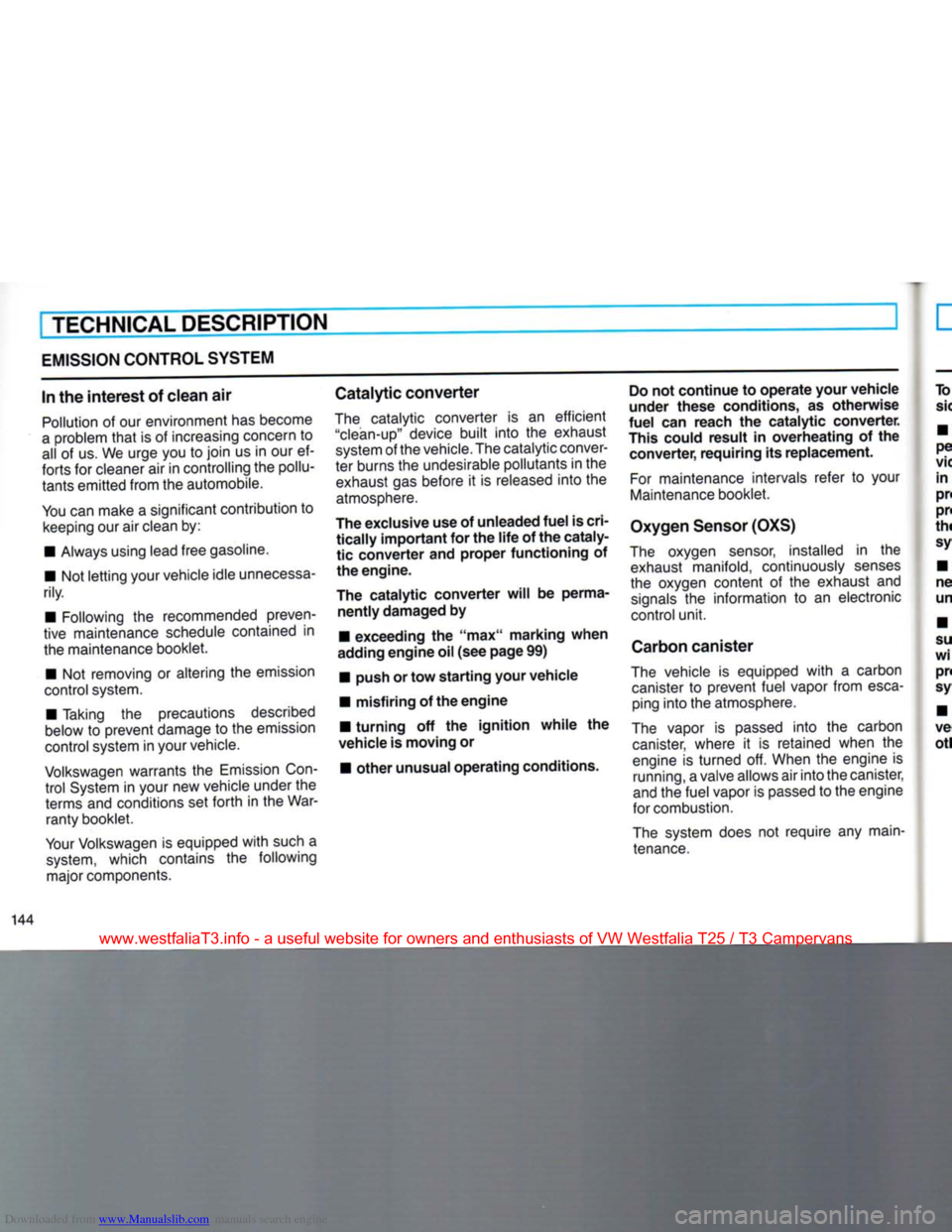
Downloaded from www.Manualslib.com manuals search engine
TECHNICAL
DESCRIPTION
EMISSION
CONTROL SYSTEM
In the
interest
of
clean
air Pollution of our environment has become
a
problem
that
is of increasing concern to
all of us. We urge you to
join
us in our ef
forts
for cleaner air in controlling the pollu
tants emitted from the automobile.
You
can make a significant contribution to
keeping our air clean by:
• Always using lead free gasoline.
• Not
letting
your vehicle idle
unnecessa
rily.
• Following the recommended preven
tive maintenance schedule contained in
the maintenance booklet.
• Not removing or altering the emission
control system.
• Taking the precautions described
below to prevent damage to the emission
control system in your vehicle.
Volkswagen
warrants the Emission
Con
trol
System in your new vehicle under the
terms and conditions set
forth
in the War ranty booklet.
Your
Volkswagen is equipped
with
such a
system,
which contains the following major components.
Catalytic
converter
The catalytic converter is an efficient
"clean-up"
device
built
into
the exhaust system of the vehicle. The catalytic conver
ter burns the undesirable pollutants in the exhaust gas before it is released
into
the
atmosphere.
The
exclusive
use of
unleaded
fuel
is cri
tically
important
for the
life
of the
cataly
tic
converter
and
proper
functioning
of
the
engine.
The
catalytic
converter
will
be
perma
nently
damaged
by
•
exceeding
the "max"
marking
when
adding
engine
oil (see
page
99)
• push or tow
starting
your
vehicle
•
misfiring
of the
engine
•
turning
off the
ignition
while
the
vehicle
is
moving
or
•
other
unusual
operating
conditions. Do not
continue
to
operate
your
vehicle
under
these
conditions, as
otherwise
fuel
can
reach
the
catalytic
converter.
This could
result
in
overheating
of the
converter,
requiring
its
replacement.
For
maintenance intervals refer to your
Maintenance booklet.
Oxygen
Sensor (OXS)
The oxygen sensor, installed in the exhaust manifold, continuously
senses
the oxygen content of the exhaust and
signals
the information to an electronic
control
unit.
Carbon
canister
The vehicle is equipped
with
a carbon canister to prevent fuel vapor from
esca
ping
into
the atmosphere.
The vapor is passed
into
the carbon canister, where it is retained when the
engine is turned off. When the engine is running, a valve allows air
into
the canister,
and the fuel vapor is passed to the engine
for combustion.
The system does not require any main
tenance.
144
www.westfaliaT3.info - a useful website for owners and enthusiasts of VW Westfalia T25 / T3 Campervans